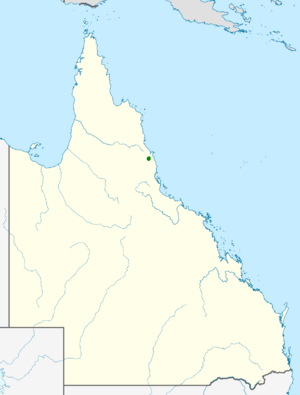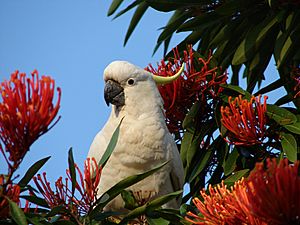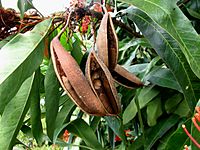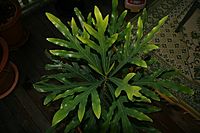Queensland tree waratah facts for kids
Alloxylon flammeum, often called the Queensland tree waratah or red silky oak, is a beautiful medium-sized tree. It belongs to the Proteaceae plant family. You can find it growing in the Queensland tropical rain forests in northeastern Australia.
This tree has shiny green leaves that are shaped like an oval, growing up to 18 cm (7.2 in) long. Its most striking feature is its bright orange-red flowers, which bloom from August to October. After the flowers, rectangular woody seed pods appear, ripening in February and March. Young Alloxylon flammeum trees have very different leaves. These leaves are large, up to 25 cm (10 in) long, and have deep lobes, looking a bit like feathers.
For a long time, this tree was known by a different scientific name, Oreocallis wickhamii. However, scientists later realized the original plant used for that name was a different species. So, in 1991, botanists Peter Weston and Mike Crisp officially gave it the new name Alloxylon flammeum. This tree is now the main example, or type species, for the Alloxylon genus. This genus includes four species from Australia and nearby islands that were once part of Oreocallis.
Alloxylon flammeum grows as a tall tree in the canopy or even taller as an emergent tree in the Mabi rainforest of north Queensland. Its tube-shaped flowers are designed to be pollinated by birds. This tree can be grown in gardens and prefers soil that drains well. It also likes extra water and special plant food that is low in a nutrient called phosphorus. Sadly, Alloxylon flammeum is listed as vulnerable in Australia. This means it's at high risk of disappearing from the wild. Most of its natural home has been cleared for farms and logging.
Quick facts for kids Queensland tree waratah |
|
|---|---|
 |
|
| Conservation status | |
| Scientific classification | |
| Genus: |
Alloxylon
|
| Species: |
flammeum
|
 |
|
| Range of A. flammeum in north Queensland | |
Contents
What the Queensland Tree Waratah Looks Like
In its natural rainforest home, the Queensland tree waratah can grow very tall, up to 33 m (108 ft). Its trunk can be about 0.6 m (24 in) wide. However, when grown in gardens, it usually reaches about 10 m (35 ft). The trunk has light grey bark with small brown spots called lenticels. New branches and leaves are covered in fine hairs.
The green leaves of the tree waratah change as the plant grows. Very young plants start with two to four leaves that have two or three lobes. After that, they grow narrow, oval-shaped leaves with smooth edges. These leaves are 6.5 to 18 cm (2.6–7.2 in) long. Then, the tree develops juvenile leaves that are deeply lobed, like a feather, and can be up to 50 cm (20 in) long. These have clear veins. Adult leaves are oval or egg-shaped, 8–25 cm (3.2–10 in) long, and sit on short stalks called petioles.
Flowers and Seeds
The bright red or orange-red flowers appear in spring, from August to October. They grow in clusters at the ends of branches. Each cluster can have 10 to 52 individual flowers. These flowers are grouped into smaller bunches of 2 to 20. Each flower sits on a small stalk called a pedicel, which can be up to 3.5 cm (1.6 in) long.
Each flower has a tube-like part called a perianth, up to 4 cm (1.8 in) long. When the flower opens, this tube partly splits to release a thick stalk called a style. The tip of the style has a disc-like part called the stigma. The outside of the flower tube and its stalk are covered in short, fine hairs.
After the flowers fade, woody, rectangular seed pods grow. These pods are 7–10 cm (2.8–4 in) long and ripen in February and March. Each pod holds 8 to 10 seeds. Each seed is separated by a thin layer and has a long, rectangular wing, which helps it fly away in the wind. Young plants that sprout from seeds have small, egg-shaped first leaves called cotyledons.
How to Tell it Apart
You can tell Alloxylon flammeum apart from a similar tree, Alloxylon wickhamii, because A. flammeum has hairy stems and leaf stalks. Its flowers are also brighter. Another species, A. brachycarpum from New Guinea, looks similar but has duller flowers and shorter, wider leaves. A. pinnatum has adult leaves that are deeply lobed and much larger flower clusters with 50 to 140 individual flowers. A. pinnatum also has crimson (dark red) pollen, while A. flammeum has yellow pollen.
The Story Behind the Name
For many years, Alloxylon flammeum was incorrectly identified as Embothrium wickhamii (and later Oreocallis wickhamii). A botanist named Frederick Manson Bailey even drew it under that wrong name in 1899. Another scientist, Ferdinand von Mueller, had described what is now known as Alloxylon wickhamii. However, he also collected samples of A. flammeum in 1881, not realizing it was a different tree.
It wasn't until the 1980s that botanists discovered there were actually two distinct species in the region. Peter Weston and Mike Crisp from the Royal Botanic Gardens in Sydney studied the Australian trees in the Oreocallis genus. They realized these trees were different from their relatives in South America. So, in 1991, they created a new genus called Alloxylon for them.
They gave the tree its current scientific name, Alloxylon flammeum. The first official sample of this tree was collected by Garry Sankowsky and Peter Radke in August 1987. Weston and Crisp chose A. flammeum to be the type species for the new Alloxylon genus. This means it's the example that defines the whole group.
Besides Queensland tree waratah, this tree has many other common names like satin oak, pink silky oak, red silky oak, and red oak. The name Alloxylon comes from Ancient Greek words: allo- meaning "other" or "strange," and xylon meaning "wood." This refers to how its wood cells are different from related trees like Telopea. The species name flammeum is Latin for "flame-coloured," which perfectly describes its bright flowers.
Alloxylon flammeum is part of a larger group of plants called the Embothriinae. This group also includes the famous Australian waratahs (Telopea), South American Oreocallis, and the Chilean firetree (Embothrium coccineum). Most of these plants have red flowers at the ends of their branches. Scientists believe that these shared features, like the red flowers, existed before the supercontinent Gondwana split apart over 60 million years ago, forming Australia, Antarctica, and South America. The way the flowers are shaped and colored suggests they have been pollinated by birds, like honeyeaters, since ancient times.
Where the Tree Waratah Lives
The Queensland tree waratah is found in the Wet Tropics region of Australia. It grows on the Atherton Tablelands in Far North Queensland. You can find it at elevations between 700 to 820 m (2,300–2,700 ft) above sea level. Its natural range stretches from Danbulla to the upper Barron River.
Sadly, much of its rainforest home has been cleared for farming. Today, you can mostly find it in protected areas. These include Mount Hypipamee National Park, Danbulla National Park, Crater Lakes National Park, Curtain Fig Tree National Park, and Hallorans Hill Conservation Park.
This tree grows in forests with rich soil that comes from basalt or granite rock. It is a key part of the complex notophyll vine forest, also known as Mabi forest. In these forests, Alloxylon flammeum grows as a tall tree in the main canopy or even taller as an emergent tree. The Mabi forest has an uneven canopy that can reach around 45 m (100 ft) high, with many smaller plants growing underneath. Here, Alloxylon flammeum shares its home with other trees like candlenut (Aleurites rockinghamensis), fig trees (Ficus spp.), and red cedar (Toona ciliata).
Protecting the Tree Waratah
Alloxylon flammeum is listed as vulnerable under Australia's Environment Protection and Biodiversity Conservation Act 1999 (EPBC Act). This means there's a high chance it could become extinct in the wild in the near future. It's also listed as vulnerable by the International Union for Conservation of Nature (IUCN).
The main reason it's vulnerable is that most of its natural habitat has been destroyed for farming and building. The remaining forests where it grows are small and separated from each other. Also, the trees grown in gardens might all come from a small group of parent plants, which means they have less variety in their genes. With less than 2% of its original forest home left, the rainforest is also threatened by invasive plants and animals that graze there.
Growing the Tree Waratah

Even though it's not super common in gardens, Alloxylon flammeum is the toughest and most adaptable of its kind. It can even grow in cooler places like Victoria. It grows best in soil that drains well and has lots of organic material, but not too much phosphorus. It's good to put mulch around the plant and give it extra water when it's dry. Using plant food that is high in phosphorus can harm the tree, so it's better to use fertilizers made for Australian native plants. If new leaves turn yellow, it might mean the plant needs iron. You can fix this with iron supplements.
The bright flowers of the tree waratah attract birds to gardens, which is a lovely sight. There's a large Alloxylon flammeum tree growing in the Royal Botanic Gardens in Sydney. It's believed that there are now more of these trees growing in gardens than there are in the wild.
How to Grow New Plants
You can usually grow new Alloxylon flammeum trees from seeds. You can also try using semi-hardened cuttings from the plant, but these can be slow to grow roots. Young plants from cuttings might have weak roots at first and need stakes to support them. Experiments have shown that cuttings grow best with a rooting hormone, regular misting, and warm roots.
Trees grown from seeds might take seven or eight years to flower. They usually start flowering soon after their leaves change from the young, lobed shape to the adult, oval shape. Another way to grow them is by grafting. This means attaching a piece of a mature tree (called a scion) onto a young plant's root system (called a rootstock). This combines a strong root system with a part of the plant that can flower quickly. Alloxylon flammeum has also been considered as a rootstock for the harder-to-grow A. pinnatum. The beautiful flowers of Alloxylon flammeum also have potential to be used as cut flowers. Its soft, silky wood is also highly valued.
See also
 In Spanish: Alloxylon flammeum para niños
In Spanish: Alloxylon flammeum para niños






